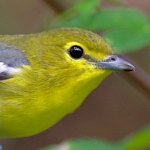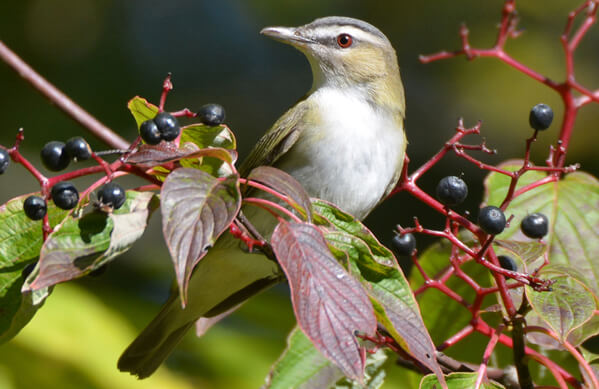About the Yellow-throated Vireo
The chunky, colorful Yellow-throated Vireo is one of the most eye-catching of North America's breeding vireos (The Blue-headed Vireo is also a contender.) It's most notable for its bright yellow throat and breast, set off by broad yellow “spectacles” around the eyes. Other key ID features are greenish upperparts and gray wings with two bold white wingbars, and a white belly and undertail.
Like other vireos, the Yellow-throated has a thick, slightly hooked bill – a feature that distinguishes it from other yellow birds of similar size.
The Telltale Beak
One species that's often mistaken for a Yellow-throated Vireo is the similarly-sized Pine Warbler, which shares many look-alike features with the vireo: a yellow throat and chest, broken yellow eye ring, and white belly and undertail.
The key to distinguishing the Yellow-throated Vireo from the Pine Warbler is its thick, slightly hooked beak – quite different from the warbler's straight bill. The two species are also proportioned differently, with the stockier vireo appearing large-headed. Another ID key: The Yellow-throated Vireo has plain, unstreaked white flanks, while the Pine Warbler shows blurry streaking on its sides.
Other yellow birds, such as the winter-plumaged or female Scarlet Tanager, Prairie Warbler, and Yellow Warbler, can also be misidentified as a Yellow-throated Vireo at a quick glance. With this species, the beak size and shape are the key to an accurate ID!
Songs and Sounds
The Yellow-throated Vireo's song is a slow, burry, and repeated “three-eight…three-eight”.
Listen to this distinctive song here:
Its call is a rough-sounding, often descending,chatter:
Breeding and Feeding
Vireo on the Edge
Although the Yellow-throated Vireo nests in forest-edge habitats, it still requires good-sized blocks of forest to breed successfully. One study in the northeastern United States found that Yellow-throated Vireo breeding density decreased significantly in forests smaller than 250 acres.
A newly-arrived male Yellow-throated Vireo will select several potential nest sites within his territory, even placing small amounts of nest-building materials at different places. He displays to potential mates at these areas; a female may accept his choice of nest site, or the pair may select a new site for their nest.
The male does much of the initial nest-building, while the female contributes, then slowly takes over, eventually completing the structure. Their nest is a hanging open cup, suspended from a forked branch high in the canopy. The nest is built of bark strips, dry grasses, and plant fibers, lined with soft hair and fine grasses and bound together with spider webs. The outside of the nest is beautifully decorated with lichens and moss.

After the female lays her clutch of 3-4 eggs, the male Yellow-throated Vireos takes turns with her to incubate, then brood the young after they hatch. Incubation takes about two weeks. Brown-headed Cowbirds often parasitize Yellow-throated Vireo nests, but sometimes the vireos will build a new nest over the alien eggs and lay another clutch of their own on top.
Both parent vireos feed their young, which grow quickly and fledge in about two weeks. The fledglings remain near the nest, depending on the adults for food, for another several weeks.
Slow Food
The Yellow-throated Vireo is a slow, rather methodical feeder, foraging through the mid and upper tree canopy in a leisurely fashion. During the summer, it dines mainly on a variety of insects, picking them from tree trunks, branches, and leaves. It may add small fruits and seeds to its diet during the fall and winter.
Region and Range

The Yellow-throated Vireo breeds throughout eastern North America, from southeastern Manitoba and Ontario south to the Gulf Coast states. During the breeding season it can be found along deciduous forest edges, mature riparian corridors, and in open woods with tall trees in parks and suburban areas.
On its wintering grounds in the Caribbean, Central, and South America, the Yellow-throated Vireo is found in a wider variety of forest types, including tropical evergreen forest, cloud forest, pine-oak forest, dry forest, thorny scrub, and even urban areas with suitable shade trees. It may also winter in mangrove swamps and coffee plantations. It may associate with mixed feeding flocks of other migrant and resident species, but defends winter feeding territories against others of its kind.
Conservation

Help support ABC's conservation mission!
During the early 20th century, the Yellow-throated Vireo suffered steep declines due to widespread pesticide spraying for Dutch Elm and other tree diseases. Increased awareness and controls of these chemicals have led to a rebound in their populations. A neotropical migrant like its close relatives the Red-eyed and White-eyed Vireos, the Yellow-throated Vireo contends with threats including habitat loss and fragmentation on both breeding and wintering grounds and collisions with glass and communication towers.
ABC provides a number of resources to help reduce these threats. Our collisions program helps to prevent communications tower collisions and fatalities, and provides solutions to prevent bird collisions with glass, particularly at home windows. We are involved in a number of large-scale conservation initiatives to protect and recover habitat on breeding and wintering grounds, including BirdScapes, Joint Ventures, and Southern Wings.
Get Involved
Policies enacted by the U.S. Congress and federal agencies, such as the U.S. Fish and Wildlife Service, have a huge impact on migratory birds. You can help shape these rules for the better by telling lawmakers to prioritize birds, bird habitat, and bird-friendly measures. To get started, visit ABC's Action Center.
Living a bird-friendly life can have an immediate impact on migratory birds in the United States. Doing so can be as easy as adding native plants to your garden, avoiding pesticides, and keeping cats indoors. To learn more, visit our Bird-Friendly Life page.
American Bird Conservancy and our Migratory Bird Joint Venture partners have improved conservation management on more than 8.5 million acres of U.S. bird habitat — an area larger than the state of Maryland — over the last ten years. That's not all: With the help of international partners, we've established a network of more than 100 areas of priority bird habitat across the Americas, helping to ensure that birds' needs are met during all stages of their lifecycles. These are monumental undertakings, requiring the support of many, and you can help by making a gift today.























































